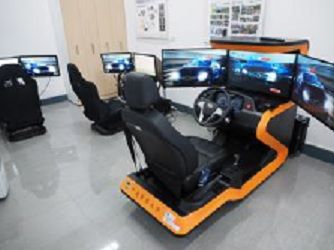The Taiwanese Central Police University has recently completed the installation of an additional Forum8 drive simulator at its training facility located in the city of Taoyuan. The Central Police University is the only educational institute of its type dedicated to training the future leaders of the Taiwan police in the latest traffic science with the primary role of maintaining security and traffic safety throughout the country.
Students’ studies include latest traffic rules, how to treat and investigate accidents, traffic process management, and traffic safety management, with lecturers involved in researching as well as teaching in these fields.
The Taiwan Police have to regularly deal with a number of specific traffic and driver-related situations particularly motorcycles frequently changing lanes and drivers of parked cars suddenly opening their doors without considering other road users or pedestrians. The Forum8 drive simulators enables students to learn how to react to these and other common scenarios without leaving the classroom and under safely controlled conditions.
 The addition of the new simulator means that the University now has three of the Forum8 systems, which are networked together to enable students to train in groups managed from a central control desk. Based on award-winning 3D virtual reality software, VR Design Studio (aka UC win-Road), the simulators provide the students with a highly realistic 3D experience of driving through Taiwan City’s streets, tunnels and bridges as well as local country roads using production-class vehicle controls that are able to reproduce the motion and feel of driving a normal police car on different road surfaces.
The addition of the new simulator means that the University now has three of the Forum8 systems, which are networked together to enable students to train in groups managed from a central control desk. Based on award-winning 3D virtual reality software, VR Design Studio (aka UC win-Road), the simulators provide the students with a highly realistic 3D experience of driving through Taiwan City’s streets, tunnels and bridges as well as local country roads using production-class vehicle controls that are able to reproduce the motion and feel of driving a normal police car on different road surfaces.
During each session, the instructor is able to change the light and weather conditions to provide the widest experience of driving at different times of day or night as well as in rain, hail, snow, and fog. The software also includes a selection of 25 scenarios representing the typical traffic conditions found in Taiwan, including RTAs, pedestrians stepping into the road, sudden lane swapping and failure of other drivers to obey traffic signals and road junction etiquette, that the instructor can activate at random intervals.
At the end of each training session the simulator screen displays an evaluation of the student’s driving skills against a range of parameters including correct lane keeping and maintaining proper distance to the vehicle in front, the use of the steering wheel, accelerator and brake pedal as well as the avoidance of collision and reaction times in emergency situations. Drivers can also get feedback by comparing their own driving course to the driving course taken by a model driver.
Associate Professor Pi-Chang Chuang, the director of the Traffic faculty at the University explains some of the plans for the simulators: “We want to develop original scenarios to enable us to analyse the impact of incidents that could lead to major traffic flow restrictions. With the ability to build realistic, detailed cityscape models, including buildings, VR Design Studio (aka UC-win/Road) can be used to help in planning for an emergency evacuation drills in case of a terrorist incident, a major fire or earthquake.”
For the next phase of development, the University is planning to upgrade the simulators with a motion platform to enhance the realistic driving experience even further for the students.





